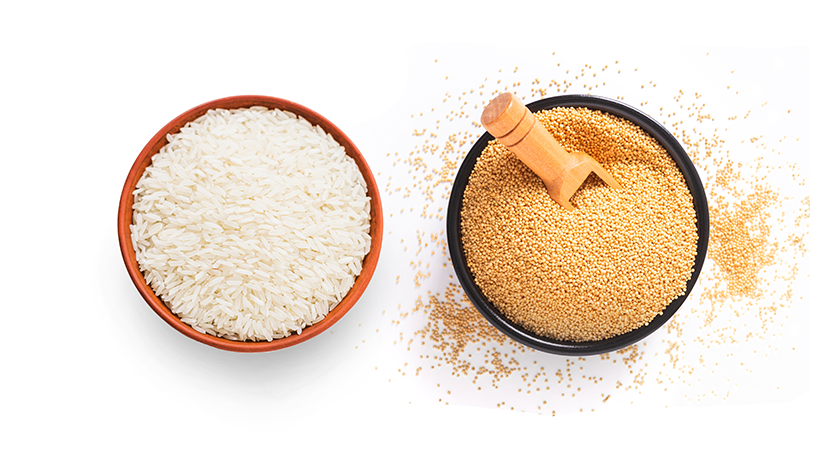- MOST RECENT
Rice Flour Nutrition, Health Benefits - 24 Mantra Organic

Mindboggling Facts and Benefits of Rice Flour
 28.10.2020
28.10.2020
Rice flour is a staple in South India. You will find it in snacks like murukku and puttu, as well as in mains like neer dosa and akki roti or aripathiri. But did you know that this ingredient is also widely used in Southeast Asian countries like Vietnam, Japan, and Korea? Think of delicacies like rice cake, mochi, rice paper rolls, and rice noodles, and you will discover the versatility of rice flour.

As with any flour, the quality of rice grains that is milled to produce the rice flour matters the most. Considering that rice is grown in stagnant water, the use of chemicals, such as pesticides and insecticides, can make their way inside. Hence, you must choose organic rice and organic rice flour. In addition to being healthier, organic rice and rice flour are also tastier than their inorganic counterparts.
So, if you are looking for rice flour nutrition, health benefits, and uses, then you have come to the right place! Let’s take a look.
Rice Flour Nutrition, Health Benefits, and Limitations
We will take a holistic look at the nutritional content of rice flour, like calories, vitamins, minerals, etc.
Rice Flour: Nutrition Facts
Rice flour is available in white and brown variants, depending on the source. You may have also heard of sweet white rice, obtained from short-grain sticky rice. However, sweet rice flour is relatively uncommon.

White rice flour has a fine texture while brown rice is more granular because of the bran. Additionally, rice flour nutrition for brown and white also differ slightly.
Here is a head-to-head comparison of white and brown rice flour nutrition per 100 grams:
| White Rice Flour |
Brown Rice Flour |
|
| Rice flour calories | 366 kCal | 363 kCal |
| Total Carbohydrates | 80.1 g |
76.5 g |
| Dietary Fibres | 2.4 g | 4.6 g |
| Protein | 5.9 g |
7.2 g |
| Vitamin E (Alpha Tocopherol) | 0.1 mg | 1.2 mg |
| Niacin | 2.6 mg |
6.3 mg |
| Folate | 4.0 mcg | 16.0 mcg |
| Pantothenic Acid | 0.8 mg |
1.6 mg |
| Calcium | 10.0 mg | 11.0 mg |
| Iron | 0.4 mg |
2.0 mg |
| Magnesium | 35.0 mg | 112 mg |
| Phosphorus | 98.0 mg |
337 mg |
| Potassium | 76.0 mg | 289 mg |
| Sodium | 0.0 mg |
8.0 mg |
| Zinc | 0.8 mg | 2.5 mg |
| Copper | 0.1 mg |
0.2 mg |
| Manganese | 1.2 mg | 4.0 mg |
| Selenium | 15.1 mcg |
0.0 mcg |
On comparing the rice flour nutrition, it becomes clearer that brown rice flour calories are marginally lower than rice flour calories in white rice flour. It is also loaded with essential minerals, making it a healthier alternative.
Health Benefits of Rice Flour
Rice flour possesses the following health benefits:
- Since it is gluten-free, it is an excellent choice for those suffering from gluten intolerance and autoimmune conditions, such as Celiac.
- It contains a healthy amount of insoluble fibres, which keep the digestive tract in optimum shape. A high-fibre diet can also improve cardiovascular health, manage blood sugar levels, and regularise bowel movement.
- Rice flour is rich in calcium, and this rice flour nutrition makes it an excellent food choice to maintain bone and skeletal health.
- White rice flour (100g) contains 9.2mg of Choline, which prevents the buildup of fat and cholesterol in your liver. Thus, it helps maintain your liver health.
- Due to its high mineral density, especially Zinc, rice flour can give the body’s natural immune response a boost.
- Rice flour contains a healthy amount of protein, which makes it a go-to ingredient if you wish to bulk up and gain muscles.
- One can use rice flour as a natural exfoliant due to its coarse texture. It is highly effective in removing dead skin and debris from your skin’s surface.
- Another cosmetic usage of rice flour is available through the application of face packs and masks, which can offer an array of favourable results ranging from skin tightening to getting rid of dark circles.

Drawbacks of Rice Flour vs. Whole Wheat Flour
While rice flour nutritional profile is impressive, it comes with the following limitations:
Less Folate Content
Wheat flour and rice flour possess comparable nutritional values with a close neck-to-neck race. However, whole wheat flour contains a solid 44mcg of folate, while even the folate-rich brown rice flour delivers a modest 16mcg.
Fewer Phytonutrients
Whole wheat flour and rice flour both contain lignan, a plant-based phytonutrient. However, whole wheat flour possesses 30% more lignans than rice flour. Given that lignans display cancer-fighting capabilities along with lowering cholesterol and cardiovascular health issues, this could be a determining factor while choosing between the two!
You now know about the rice flour nutrition, its health benefits, and drawbacks against whole wheat flour. This information will help you make an informed decision on what to include in your diet!
Try 24 Mantra Organic’s Rice Flour and Savour the taste of organic goodness.


